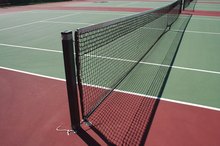How Much Sand Does a Volleyball Court Need?
Volleyball courts provide a local outdoor recreation for professional and amateur athletes. Designing your own sand volleyball court requires planning and preparation and costs in excess of $6,000 to $10,000 as of pricing in April 2011. Determining the amount of materials needed is simple and based on the desired dimensions of your court.
Formula for Amount of Sand Needed
Multiply the length times the width times the depth of your court, taking into consideration that a standard court measures 18 meters by nine meters, or 59 feet by 29.5 feet. But because you should have a least a 3-meter perimeter around the court, your total measurements should be 24 meters by 15 meters for an amateur court or 28 by 19 meters for a professional court. The standard depth for your volleyball court should include about one foot of sand, with pea-sized No. 56 gravel and a leech field below. Divide your length x width x depth measurement by 27 and then multiply by 1.6 to determine the tonnage required. The average professional court requires approximately 166 tons of sand.
- Multiply the length times the width times the depth of your court, taking into consideration that a standard court measures 18 meters by nine meters, or 59 feet by 29.5 feet.
- The standard depth for your volleyball court should include about one foot of sand, with pea-sized No.
Expense of Sand
Portable Basketball Goal Sand Vs. Water
Learn More
There are several aspects to consider when selecting and pricing your sand. Taking sand from a local beach is illegal, but offering to clean up sand that has blown onto a parking lot or roadway can be an economical and environmentally conscious option if you are not seeking to install your court quickly. The average cost as of April 2011 for washed masonry sand varies from $8.50 to $15 per ton, but the delivery fee can be drastically different depending on your location relative to the source of the sand.
Selection of Sand
Take care when choosing the sand you will use for your volleyball court 1. Look for sand that closely resembles beach sand. Avoid coarse sand as it will be uninviting when a player lands on it and can cause increased incidence of skin injury and irritation. Using a sugar-like fine sand is also not desirable because when it becomes wet, it will compact and turn mud-like. Selecting the best sand provides the best playing surface and increases the longevity of your medium.
- Take care when choosing the sand you will use for your volleyball court 1.
- Using a sugar-like fine sand is also not desirable because when it becomes wet, it will compact and turn mud-like.
General Court Design
Homemade Volleyball Poles
Learn More
For optimal playing, position your court with the net running from east to west, which reduces the morning and evening sun glare into the player's eyes. Remember to pile up the excavated soil around 3 sides of the court, making a horseshoe-like shape and allowing for drainage at the fourth side. Avoid any hard barriers at the boundaries of the court, such as railroad ties, and opt for compliant materials that will reduce the risk of injury to players chasing the ball outside the court boundaries.
- For optimal playing, position your court with the net running from east to west, which reduces the morning and evening sun glare into the player's eyes.
- Avoid any hard barriers at the boundaries of the court, such as railroad ties, and opt for compliant materials that will reduce the risk of injury to players chasing the ball outside the court boundaries.
Related Articles
References
Writer Bio
Melissa Sabo is an occupational therapist who started writing professional guidebooks for all Flagship Rehabilitation employees in 2009. Specializing in applied therapy and exercise for non-medical readers, she also coauthored a manual on wheelchair positioning. She graduated from the University of Pittsburgh with a Bachelor of Science in occupational therapy.









